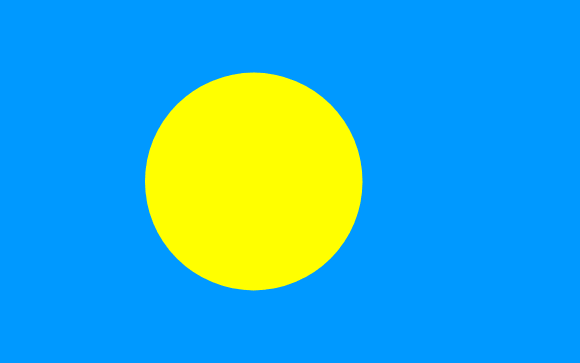Palau Flag

When the island group split from the United Nations Trust Territory on January 1, 1981, the flag of Palau was adopted. The flag has a light blue field that reflects the Pacific Ocean and the nation's location within it, which is shared with the Federated States of Micronesia and other Pacific island groupings. The bright blue field also depicts Palau's transition from foreign rule to self-government.
A golden disk rests slightly off-center towards the hoist on the flag, representing the full moon, a symbol of peace, love, and tranquillity. The Palauans regard the full moon as the best period for human activity, and numerous traditional events such as festivities, fishing, sowing, harvesting, tree-felling, and the carving of traditional canoes take place during this time.
Prior to this flag, the Trust Territory of the Pacific Islands flew alongside the United Nations and American flags. The disc on the flag is similar to that on the Japanese flag, but its shape is more akin to that on the Bangladesh flag, except that this disc signifies the moon rather than the sun.
Palau flag downloads
- completely free for commercial and non-commercial use (public domain)
- based on vector file from Wikipedia Commons
- PNG or WebP format (lossless compression)
- Right click on the links (save link as)
| Width | Height | PNG | WebP |
|---|---|---|---|
| 20px | 13px | ~0.1 KB | ~0.1 KB |
| 40px | 25px | ~0.4 KB | ~0.1 KB |
| 80px | 50px | ~0.7 KB | ~0.1 KB |
| 160px | 100px | ~2.6 KB | ~0.6 KB |
| Width | Height | PNG | WebP |
|---|---|---|---|
| 16px | 12px | ~0.1 KB | ~0.1 KB |
| 40px | 30px | ~0.4 KB | ~0.1 KB |
| 80px | 60px | ~0.8 KB | ~0.1 KB |
| 128px | 96px | ~2.5 KB | ~0.6 KB |
- completely free for commercial and non-commercial use (public domain)
- based on vector file from Wikipedia Commons
- PNG, WebP (lossless compression) or JPEG format (100% quality)
- Right click on the links (save link as)
| Width | Height | PNG | WebP | JPEG |
|---|---|---|---|---|
| 2560px | 1600px | ~2.6 KB | ~0.6 KB | ~34.9 KB |
| 1280px | 800px | ~0.7 KB | ~0.1 KB | ~13.0 KB |
| 640px | 400px | ~0.4 KB | ~0.1 KB | ~5.6 KB |
| 320px | 200px | ~0.2 KB | ~0.1 KB | ~2.8 KB |
| 160px | 100px | ~0.1 KB | ~0.1 KB | ~1.5 KB |
| 80px | 50px | ~0.1 KB | ~0.1 KB | ~0.9 KB |
| 40px | 25px | ~0.1 KB | ~0.1 KB | ~0.6 KB |
| 20px | 13px | ~0.1 KB | ~0.1 KB | ~0.4 KB |
- completely free for commercial and non-commercial use (public domain)
- based on vector file from Wikipedia Commons
- SVG, PDF (Adobe Acrobat), AI (Adobe Ilustrator) or EPS format
- Right click on the links (save link as)
| Format | SVG | AI | EPS | |
|---|---|---|---|---|
| Vector download | ~0.3 KB | ~12.5 KB | ~29.7 KB | ~1533.8 KB |
Country information
Palau is a small island nation located in the western Pacific Ocean, about 2,000 miles east of the Philippines. It is a sovereign country with a unique blend of Micronesian, Melanesian, and Polynesian culture. Palau is known for its stunning natural beauty, with a rugged coastline, crystal clear waters, and lush forests.
The history of Palau dates back to ancient times, with the first human settlements dating back to at least 1000 AD. The islands were first explored by Europeans in the late 18th century, and were later annexed by the Spanish and later the Germans. Palau became a territory of the United States after World War II, and gained independence in 1994.
The economy of Palau is small and largely dependent on foreign aid and tourism. The country has a tropical climate, with hot and humid weather year-round. The official language of Palau is Palauan, a Micronesian language, and the country has a diverse population with a mix of different ethnicities and religions.
| Independent | Yes |
| Country codes | PW, PLW (ISO 3166-1) |
| Official name | Republic of Palau |
| Official languages | Palauan |
| Religion | 89.7% Christianity, 5.7% Modekngei, 3.0% Islam, 1.6% Other / None |
| Capital city | Ngerulmud |
| Continent | Oceania |
| Time zone | UTC+9 (PWT) |
| Member of | United Nations |
| Pacific Community | |
| Population | 18,316 (2023) |
| Population density | 39 per Km2 (102 people per mi2) |
| Urban Population | 100% of the population is urban (18,094 people in 2020) |
| Migrants (net) | / |
| Median age | / |
| Total area | The total land area is 460 Km2 (178 sq. miles) |
| Highest point | Mount Ngerchelchuus on Babeldaob (242 m, 794 ft) |
| Lowest point | North Pacific Ocean |
| GDP per capita | $ 12,083 (World Bank, 2021) |
| Currency | United States dollar ($, USD) |
| Calling code | +680 |
| Internet TLD | .pw (click here to find and register domain name) |
| Country Wikipedia Page | Palau Wikipedia Page |
Main Cities by Population in Palau
| # | CITY NAME | POPULATION |
|---|---|---|
| 1 | / | / |
